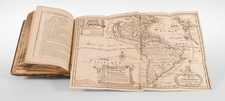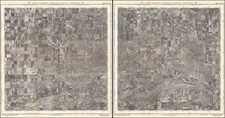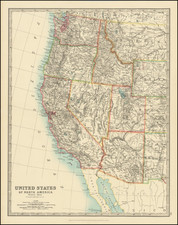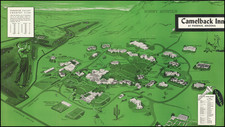Globe, Arizona in 1929
A fire insurance atlas of Globe, Gila County, Arizona, produced by the Sanborn Map Company in April 1929, offers a detailed record of the built environment of this Arizona town, site of the Old Dominion Copper Company's smelter operations. Comprising 28 unbound sheets with hand-colored maps, the atlas was originally made as a specialized tool for insurance company underwriters in determining the degree of fire risk associated with any property shown therein. Today it is an unrivaled visual record of Globe's urban and architectural landscape for the time.
Executed with a scale 800 feet to an inch, every structure in Globe is accurately shown with block-by-block, street-by-street, structure-by-structure representations. The Old Dominion Co.'s copper smelter and related structures dominate the area. Use of every structure is given: dwelling, grocery, storage, lumber yard, church, hardware, water tower, etc., often recording the name of the individual business owner noted. Color coding denotes building material.
In the 1920s, Globe, Arizona was primarily shaped by the copper mining industry, with the Old Dominion Copper Co. serving as one of its major economic anchors. The town was a bustling hub for copper extraction, and the Old Dominion Copper Co. played a central role in both employment and economic development within the community. Alongside mining, Globe maintained a diverse social fabric, with a population comprising Native Americans, Hispanics, and Anglos. Although it was primarily known for its mineral resources, the town was also a local center for commerce. Notably, several of the buildings are noted as being made of adobe.
Here follows a selection of the diverse structures and sites shown in the atlas:
- African M. E. Church
- Arizona Commercial Mining Co.
- Arizona Edison Co. Electric Light Plant
- Chinese Masonic Hall
- Gila City Water Works
- Gila County Hospital
- Globe Foundary & Machine Co.
- Iron Cap Copper Co.
- J. C. Penney Dept. Store
- Kinney Hotel
- Lutheran Apache Mission
- Mormon Church
- Old Dominion Co. (Copper Mining): Smelter, Power Plant and Shops, Settling Ponds, Slag Dump, etc.
- Phoenix-Tempe Stone Co.
- Southern Pacific Co.'s Railroad Shops
- Superior & Boston Copper Mining Co.
- Whalley Lumber Co.
For nearly a century (from 1867 to 1961), Sanborn Map Company produced their fire insurance maps for nearly all U.S. cities. Ron Tyler (Prints of the West, pages 153-55) describes the fire insurance maps as a successor to the bird’s-eye view in documenting the growth of towns and cities. The present Globe, Arizona atlas bears out Tyler's assertion.
Rarity
This atlas is very rare. OCLC locates a single example of the 1929 edition Globe Sanborn atlas, held at the University of Arizona. The Library of Congress has digitized editions of 1893, 1898, 1901, 1904, 1906, 1909, and 1911, but as of this writing their two 1929 examples have not been made available online.
The Sanborn Map Company, founded in the 1860s by Daniel Alfred Sanborn, is a renowned cartographic institution primarily recognized for its unparalleled fire insurance atlases. These atlases emerged as indispensable tools during the late 19th and early 20th centuries, portraying the evolution of urban America with unprecedented detail and precision. Charting both burgeoning metropolises and smaller municipalities, Sanborn's fire insurance maps provide a unique and illuminating perspective on the physical, economic, and social transformation of the nation during a period of intense urbanization and industrialization.
During the latter half of the 19th century, the United States witnessed an acceleration in urban growth. This shift from rural to urban living, bolstered by the advent of the Industrial Revolution, generated densely populated areas with a diverse array of architectural styles, materials, and infrastructure. In this context, the need for comprehensive maps that could illustrate the specifics of the built urban fabric became paramount, especially for insurance companies seeking to assess the risks associated with insuring individual properties. The Sanborn Map Company responded to this demand, creating elaborate maps that identified building materials, the purpose of structures, and even features like fire walls and sprinkler systems.
A standout feature of Sanborn's maps was their color-coding system, which allowed for a swift and clear differentiation between building materials—whether wood, brick, iron, or otherwise. This system, paired with the company's legends -- detailing everything from the width of streets to the locations of hydrants -- made these atlases an invaluable resource for insurance underwriters. By the turn of the 20th century, Sanborn maps covered thousands of cities and towns across the United States.
Beyond their utility to the insurance industry, the atlases produced by the Sanborn Map Company have, over time, become a treasured resource for historians, urban planners, preservationists, and environmental researchers. These maps have also been pivotal in brownfield research, shedding light on past industrial activities and potential contamination sites. They offer a window into the past, capturing the architectural, infrastructural, and environmental trends of various eras, and revealing the intricacies of a city's development. The very design of streets, the evolution of residential and commercial areas, and the rise and decline of certain industries can be traced through these maps.
Around 1960, Warren Buffett, then a burgeoning value investor, took a significant position in Sanborn Map Co., sinking 35% of his partnership's money into the company. Buffett was drawn to Sanborn's extensive map business, which he described as a virtual monopoly, as well as the company's valuable investment portfolio. While the cartographic aspect of Sanborn's business was diminishing in profitability due to technological advances introduced by competitors, Buffett recognized that the informational content of the maps had not been updated to electronic access, and was thus an undervalued asset for the company. His investment in Sanborn Map Co. is often presented as Case Study No. 1 in overviews of his value-oriented investment philosophy, which emphasized undervalued assets.
In sum, the Sanborn Map Company's fire insurance atlases are not merely maps; they are intricate tapestries of American urban history, detailing the nation's progression from the late 19th to the 20th century. Through their detailed renderings, these maps continue to serve as invaluable chronicles of the United States' urban transformation during a pivotal era.















![(Atlas of the Aegean -- Extra Illustrated!) L'Egeo redivivo o' sia chorographia dell' arcipelago, e dello stato primiero, & attuale di quell' isole. . . [The Aegean revived, or the chorography of the archipelago, and of the original and current state of those islands. . .]](https://storage.googleapis.com/raremaps/img/small/93229.jpg)
